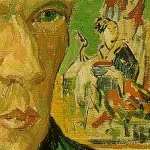
In my last entry, I discussed some of my reactions to the 1956 movie Lust for Life, an adaptation of the 1934 Irving Stone novel of the same name. I ended on a note about the film's bloodless interpretation of Theo, Vincent's brother. How the film depicts Paul Gauguin is far more interesting and far more successful. Played with a fierce, commanding self-composure by Anthony Quinn, Quinn's Gauguin is arrogant, commanding, and clear-eyed, an obvious foil to Kirk Douglas's more emotional and, toward the end of film, even raging Vincent. The different depictions of the two men certainly do point to real differences in their personalities. Vincent indeed was a far more emotionally based individual than Paul Gauguin, who could fairly be called calculating, even scheming. Gauguin should also be called a liar and a weasel, an aspect of his personality that the movie doesn't quite explore. Arguably, in the standoff between the two Yellow House roommates, in the vortex of their deteriorating relationship, the film suggests that Gauguin is the sane and reliable, even if he is also rather cold personally. (The film also suggests that Van Gogh was the much heavier drinker of the two men. Nothing factual points to that conclusion. Nothing factual even points to a great fondness for absinthe on Vincent's part, despite his reputation to the contrary. And Gauguin was the more frequent visitor to brothels--an aspect of 19th century male life, and Van Gogh's life too, that the movie simply declines to explore.)
The real Gauguin certainly was sane and cold, but never reliable. There's every indication that his famous account of Vincent's 1888 breakdown--when Vincent cut his ear off--is a network of self-serving lies, none of them verified by any other source. Unfortunately, the movie seems to rely on Gauguin's account for its lurid depiction of the event. The myth of the Tragically Mad Vincent, something I've complained about in other posts, is fully on display. But it gets only worse when the movie moves on to Vincent's last months in the quiet northern village of Auvers-sur-Oise. Without question, these were not happy months in Vincent's life. He had come to the realization that he would never be truly cured. The power of his painting had self-evidently diminished. The predicted friendship with Paul Gachet--a physician in the village who was both an art lover and had an interest in mental illness--a friendship Theo was counting on to provide support and counsel for Vincent in Auvers, turned sour rather quickly. So it is no great surprise, really, that Vincent would have decided his life and energy was all but spent, that there was no reason for him to continue on. All that said, the movie tries to portray him as not depressed but deranged. In one striking scene, a band plays in the street outside of a bar where Vincent sits desperately clinging to a drink. The music literally drives Vincent crazy as he winces and wiggles and clutches his ears trying to keep out the sound. It is the kind of scene that was likely deeply affecting to audiences when the film was released but which seems pathetically overdone now.
There is more of this Tragically Mad mythmaking in the movie's final minutes. Vincent is painting in a field, at work on what is widely--and erroneously--called his "final painting": Wheat Field with Crows. While Wheat Field with Crows is one of his last paintings, by no means was it his absolute last. In fact, art historians date it as having been completed weeks before Van Gogh died. Viewers of the painting simply would like to believe it was his last because of the strong note of foreboding in it: the threatening blue-black sky and the low-hanging bodies of crows that look like harbingers of death. Of course, people think, just before he died he painted a painting about death. It's too poetically perfect not to believe; but it's also simply wrong. The movie goes one step further. In the movie, this isn't merely Vincent's last painting but Vincent kills himself while painting it. He tries to work, but is struck by another fit similar to what is shown in the bar scene. In the anxiety of the moment, he pulls out a gun and shoots himself. "Now where would he have gotten the gun?" my sister smartly commented. Well, in fact, plenty of frenchmen owned guns in the 19th century, but Vincent was not in the habit of carrying one when he went painting. If, as is commonly held, Vincent shot himself in a field on July 27, 1890--a new biography disputes this notion and claims he was accidentally shot by someone else--he surely took the gun out with him just for this purpose. And by no means was he in the middle of painting Wheat Field with Crows, a controlled and striking painting. This shooting scene is nothing more than melodramatic Hollywood blather.
But to be fair, it's no less blather than most films of the day would have shown you. Or that most films show you now. Is Lust for Life worth watching? Yes, it still is. But please don't think that it transmits an accurate, or even sensitive, interpretation of the life of the artist. The real Van Gogh was far more complicated than the writhing, raging, movie cut up. The real Van Gogh was both more lucid and, for those who knew him best, more maddening a man.













0 comments:
Post a Comment